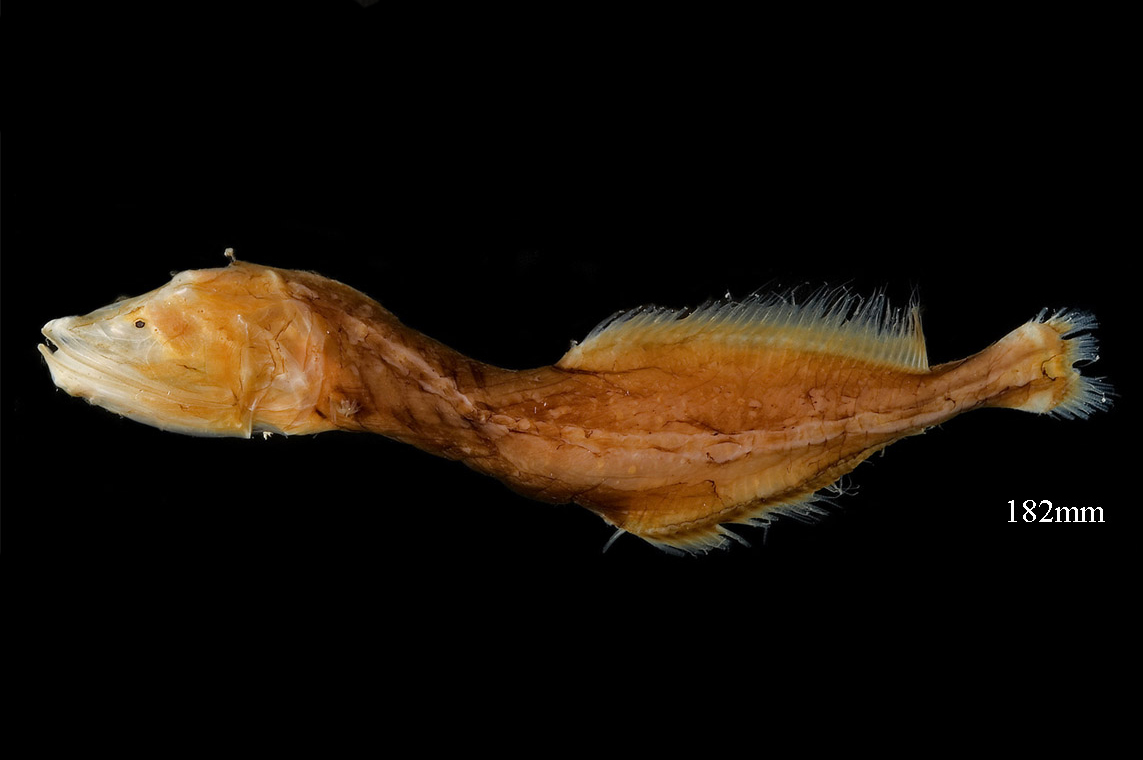Pink Flabby Whalefish, Cetostoma regani Zugmayer 1914
Other Names: Longfinned Whalefish

A female Pink Flabby Whalefish, Cetostoma regani - USNM 391656. Source: Sandra Raredon / Smithsonian Institution, National Museum of Natural History, Division of Fishes. License: CC BY Attribution-Noncommercial-ShareAlike
Summary:
A bright to dark red whalefish and dark brown to blackish dorsal, anal and caudal fins with bright red margins.
Cite this page as:
Bray, D.J. 2022, Cetostoma regani in Fishes of Australia, accessed 20 Apr 2024, https://fishesofaustralia.net.au/home/species/5087
Pink Flabby Whalefish, Cetostoma regani Zugmayer 1914
More Info
|
Distribution |
Recorded in Australia from S of Bruny Island and SE of the Pedra Branca Seamount off southern Tasmania (within the Australian EEZ). The species is circumglobal in distribution between 100 and 3,700 metres, usually between 700 and 1,200 metres during the day, with larger specimens found in deeper waters. The nocturnal distribution is between 110-700 m. |
|
Features |
Females: Dorsal fin 29-37; Anal fin 26-34; Pectoral fin 20-21; Caudal fin, principal rays 15-17; Vertebrae 47-53; Trunk canal lateral line scales/organs 15-17; Gill rakers reduced to flat patches of fine teeth. Body very elongate, head relatively short (3-5 times in SL), caudal peduncle long, narrow. Snout tapering, pointed; eye tiny; nasal organ small. Upper jaw slightly convex to straight, lower jaw concave; teeth tiny in irregular bands in both jaws. Four distinct gill arches with small slit behind. Dorsal and anal fins far back on body, bases very long and elevated; pelvic fin absent; pectoral fin small, low on body. Body flabby, naked except for large, diagnostic scales associated with lateral-line canals. Lateral line conspicuous, continuing on head as a series of pores and sensory openings; lateral line pores large, rounded, with moderate dermal flaps, located inside a channel with raised rim. Low fleshy ridges on ventral side of abdomen; cavernous tissue present around anus. Numerous small lappets around the base of each anal fin ray. Males (described as megalomycterid Cetomimoides parri) similar to females in body form but more slender and with a huge nasal rosette. Larvae (described as mirapinnid Parataeniophorus gulosus) are slender with a short tape-like extension of the caudal fin and upturned pectoral fins. |
|
Size |
Largest female 25 cm SL, commonly around 19 cm; smallest around 4 cm SL. Males range between 3.4 and 4.1 cm SL. |
|
Feeding |
Females consume crustaceans, while males do not eat after transformation. |
|
Etymology |
The species is named in honour of ichthyologist C. Tate Regan of the Natural History Museum. |
|
Species Citation |
Cetostoma regani Zugmayer 1914, Bull. l'Institut Océanogr. (Monaco) 288: 4. Type locality: Eastern Atlantic, 30°45'30"N, 25°47'W, station 3215, depth 0-2000 m. |
|
Author |
Bray, D.J. 2022 |
|
Resources |
Pink Flabby Whalefish, Cetostoma regani Zugmayer 1914
References
Fitch, J.E. & Lavenberg, R.J. 1968. Deep-water teleostean fishes of California. California Natural History Guides: 25. University of California Press, Berkeley and Los Angeles, California. 115 pp.
Harold, A. 2015. Cetostoma regani. The IUCN Red List of Threatened Species 2015: e.T190260A60786169. https://dx.doi.org/10.2305/IUCN.UK.2015-4.RLTS.T190260A60786169.en. Accessed on 25 October 2022.
Johnson, G.D., Paxton, J.R., Sutton, T.T., Satoh, T.P., Sado, T., Nishida, M. & Miya, M. 2009. Deep-sea mystery solved: astonishing larval transformations and extreme sexual dimorphism unite three fish families. Biology Letters 5(2): 235-239. https://doi.org/10.1098/rsbl.2008.0722
Paxton, J.R. 1979. Cetomimidae. p. 214. In J.C. Hureau and Th. Monod (eds.) Check-list of the fishes of the north-eastern Atlantic and of the Mediterranean (CLOFNAM). UNESCO, Paris. Vol. 1.
Paxton, J.R. 1986. Cetomimidae. p. 524-525. In P.J.P. Whitehead, M.-L. Bauchot, J.-C. Hureau, J. Nielsen and E. Tortonese (eds) Fishes of the north-eastern Atlantic and the Mediterranean. UNESCO, Paris. Vol. 2.
Paxton, J.R., 1989. Synopsis of the whalefishes (family Cetomimidae) with descriptions of four new genera. Records of the Australian Museum 41:135-206. https://doi.org/10.3853/j.0067-1975.41.1989.141
Paxton, J.R. 1999. Families Gibberichthyidae, Rondeletiidae, Barbourisiidae, Cetomimidae, Mirapinnidae, Megalomycteridae, Anoplogastridae, Diretmidae. pp. 2203-2211 in Carpenter, K.E. & Niem, T.H. (eds). The Living Marine Resources of the Western Central Pacific. FAO Species Identification Guide for Fisheries Purposes. Rome : FAO Vol. 4 pp. 2069-2790.
Paxton, J.R. & Blake, D.J. 1990. Cetomimidae. pp. 607-608 in Quéro, J.-C., Hureau, J.-C., Karrer, C., Post, A. & Saldanha, L. (eds) 1990. Check-list of the Fishes of the Eastern Tropical Atlantic. Paris : UNESCO 1492 pp., 3 vols.
Paxton, J.R., Trnski, T. & Johnson, G.D. 2016. Cetomimidae. pp. 2174-2182 in Carpenter, K.E. & De Angelis, N. (eds). The Living Marine Resources of the Eastern Central Atlantic. FAO Species Identification Guide for Fishery Purposes. Bony Fishes Part 1 (Elopiformes to Scorpaeniformes). Rome : FAO Vol. 3 pp. 1511-2350.
Tolley, S.G., Gartner, J.V. Jr. & Lancraft, T.M. 1989. Whalefishes (Beryciformes: Cetomimoidei) of the Gulf of Mexico. Bulletin of Marine Science 45(3): 671-677.
Zugmayer, E. 1914. Diagnoses de quelques poissons nouveaux provenant des campagnes du yacht Hirondelle II (1911-1913). Bulletin de l'Institut Océanographique Monaco 288: 1-4 See ref at BHL





